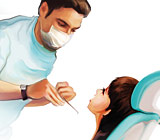Clik here to view.

At some point in every person's life, they will experience bleeding gums or gingivitis, a mild inflammation of the gingiva (gums), which is the first stage of periodontal (gum) disease. For example, when was the last time you were brushing or flossing your teeth and noticed that your gums were bleeding or that when you spit and rinsed there was some blood? When this occurs, it is a sign that you have gum disease, as healthy gum tissues do not bleed. And no, it is highly unlikely that your bleeding is from brushing too hard. You would have to use extreme force to make healthy gum tissues bleed. However, this is exactly how most people discount or ignore this warning sign.
If this sounds like you or another member of your family, here's what you can expect when you see us for treatment. Depending on the severity of your periodontal disease, all of these treatment options may not be necessary.
Behavior change: We will collect a thorough medical history to obtain facts about your oral hygiene, eating and other personal habits such as alcohol and tobacco use to determine their impact on your periodontal disease. Proper brushing and flossing techniques are necessary for everyone, whether you have early or late stage gum disease; however, you must commit to a good daily oral health routine if you want to achieve success and thus keep you mouth and teeth healthy.
Calculus (tartar) removal: Cleaning is not just your responsibility. We'll clean and polish your teeth to remove calculus (tartar), the calcified deposits of bacterial products that become glued to the teeth and roots that you can’t remove. In fact, routine visits to see us for a thorough cleaning will help ensure that all the unhealthy calculus (tartar) is removed from your teeth.
Evaluation: Usually after three or four weeks, we will want to see you to evaluate your progress and to see the response of your gingival tissues to the treatment thus far. And depending on the severity of your gum disease, we may need another follow-up exam to decide the best maintenance and monitoring regimen necessary to keep your mouth healthy.
Occlusal or Bite Therapy: This treatment, if necessary, usually occurs once your gum tissues have been stabilized and the inflammation and infection have been controlled. It is during this phase that we will address loose teeth or teeth that have shifted or drifted in position.
Surgical Therapy: For more severe cases of gum disease, you may need periodontal plastic surgery to repair and regenerate gum and bone tissue and their attachment to the teeth. It may also be necessary to replace missing teeth with dental implants.
If you are ready to talk to us about the current state of your mouth (or the mouth of another member of your family), contact us today to schedule an appointment. The first step towards achieving optimal oral health could start with this simple call. Or, you can learn more by reading, “Understanding Gum Disease.”
